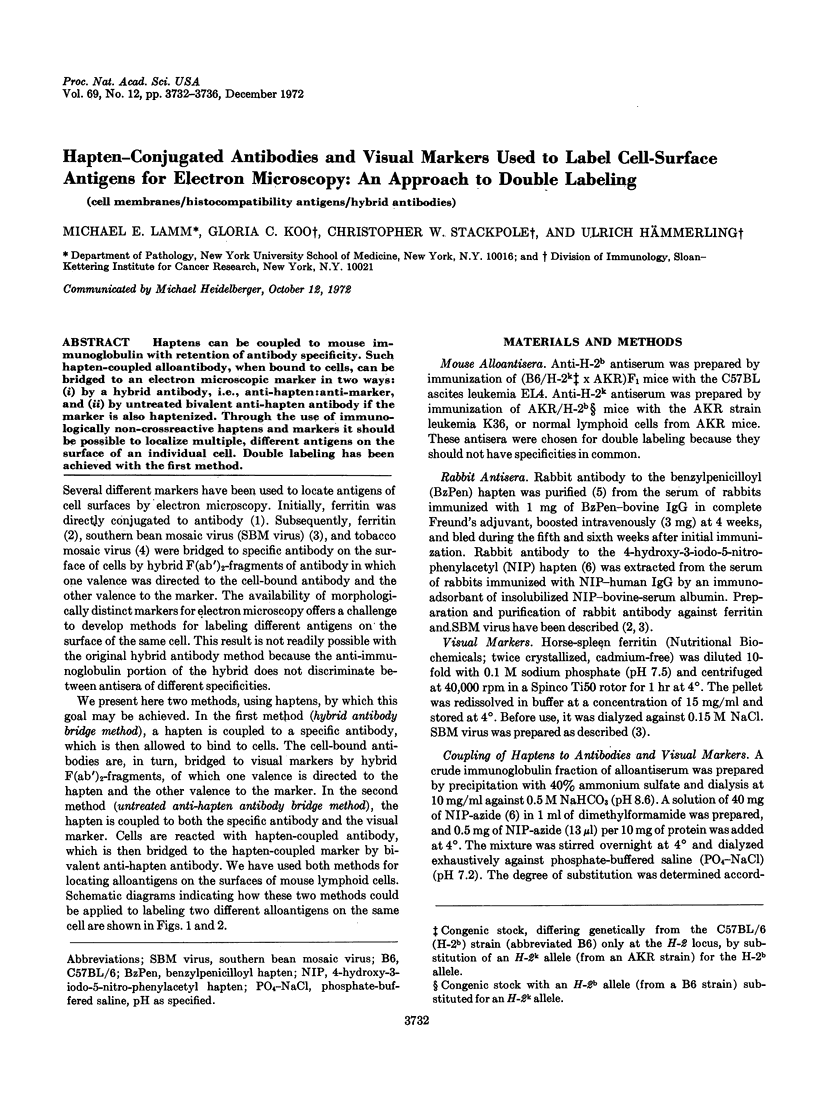Abstract
Haptens can be coupled to mouse immunoglobulin with retention of antibody specificity. Such hapten-coupled alloantibody, when bound to cells, can be bridged to an electron microscopic marker in two ways: (i) by a hybrid antibody, i.e., anti-hapten:anti-marker, and (ii) by untreated bivalent anti-hapten antibody if the marker is also haptenized. Through the use of immunologically non-crossreactive haptens and markers it should be possible to localize multiple, different antigens on the surface of an individual cell. Double labeling has been achieved with the first method.
Keywords: cell membranes, histocompatibility antigens, hybrid antibodies
Full text
PDF




Images in this article
Selected References
These references are in PubMed. This may not be the complete list of references from this article.
- Aoki T., Wood H. A., Old L. J., Boyse E. A., De Harven E., Lardis M. P., Stackpole C. W. Another visual marker of antibody for electron microscopy. Virology. 1971 Sep;45(3):858–862. doi: 10.1016/0042-6822(71)90214-5. [DOI] [PubMed] [Google Scholar]
- Brownstone A., Mitchison N. A., Pitt-Rivers R. Chemical and serological studies with an iodine-containing synthetic immunological determinant 4-hydroxy-3-iodo-5-nitrophenylacetic acid (NIP) and related compounds. Immunology. 1966 May;10(5):465–479. [PMC free article] [PubMed] [Google Scholar]
- Farquhar M. G., Palade G. E. Cell junctions in amphibian skin. J Cell Biol. 1965 Jul;26(1):263–291. doi: 10.1083/jcb.26.1.263. [DOI] [PMC free article] [PubMed] [Google Scholar]
- Frye L. D., Edidin M. The rapid intermixing of cell surface antigens after formation of mouse-human heterokaryons. J Cell Sci. 1970 Sep;7(2):319–335. doi: 10.1242/jcs.7.2.319. [DOI] [PubMed] [Google Scholar]
- Hämmerling U., Aoki T., Wood H. A., Old L. J., Boyse E. A., de Harvin E. New visual markers of antibody for electron microscopy. Nature. 1969 Sep 13;223(5211):1158–1159. doi: 10.1038/2231158a0. [DOI] [PubMed] [Google Scholar]
- Hämmerling U., Aoki T., de Harven E., Boyse E. A., Old L. J. Use of hybrid antibody with anti-gamma-G and anti-ferritin specificities in locating cell surface antigens by electron microscopy. J Exp Med. 1968 Dec 1;128(6):1461–1473. doi: 10.1084/jem.128.6.1461. [DOI] [PMC free article] [PubMed] [Google Scholar]
- Levine B. B., Levytska V. Hapten-specific insoluble immunoabsorbents prepared from hide powder (collagen). J Immunol. 1969 Mar;102(3):647–655. [PubMed] [Google Scholar]
- NISONOFF A. ENZYMATIC DIGESTION OF RABBIT GAMMA GLOBULIN AND ANTIBODY AND CHROMATOGRAPHY OF DIGESTION PRODUCTS. Methods Med Res. 1964;10:134–141. [PubMed] [Google Scholar]
- NISONOFF A., RIVERS M. M. Recombination of a mixture of univalent antibody fragments of different specificity. Arch Biochem Biophys. 1961 May;93:460–462. doi: 10.1016/0003-9861(61)90296-x. [DOI] [PubMed] [Google Scholar]
- Nicolson G. L., Hyman R., Singer S. J. The two-dimensional topographic distribution of H-2 histocompatibility alloantigens on mouse red blood cell membranes. J Cell Biol. 1971 Sep;50(3):905–910. doi: 10.1083/jcb.50.3.905. [DOI] [PMC free article] [PubMed] [Google Scholar]
- REYNOLDS E. S. The use of lead citrate at high pH as an electron-opaque stain in electron microscopy. J Cell Biol. 1963 Apr;17:208–212. doi: 10.1083/jcb.17.1.208. [DOI] [PMC free article] [PubMed] [Google Scholar]
- Silvestre D., Kourilsky F. M., Nicolai M. G., Levy J. P. Presence of HLA antigens on human reticulocytes as demonstrated by electron microscopy. Nature. 1970 Oct 3;228(5266):67–68. doi: 10.1038/228067a0. [DOI] [PubMed] [Google Scholar]



